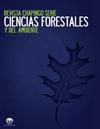Minimum sample size for fitting compatible taper-volume functions for three pine species in Chihuahua
IF 0.6
4区 农林科学
Q3 Agricultural and Biological Sciences
Revista Chapingo Serie Ciencias Forestales Y Del Ambiente
Pub Date : 2020-12-01
DOI:10.5154/r.rchscfa.2020.04.031
引用次数: 0
Abstract
Introduction: The choice of sample size is an important decision in the development of volume models and taper functions. Objective: To calculate the minimum sample size required for fitting compatible taper-volume functions for Pinus arizonica Engelm., P. durangensis Martinez and P. engelmannii Carr. in Chihuahua. Materials and methods: The methodology was divided into three phases: (i) fitting of a linear regression model to the diameter-height data of 50 trees of each species in the three forest regions; (ii) calculation of the minimum sample size required, and (iii) comparison of the goodness of fit of the taper-volume function using both sample sizes. Results and discussion: The minimum number of trees calculated ranged from 53 (Pinus durangensis) to 88 (P. engelmannii) and it is located in the interval reported in studies carried out to estimate the optimal sample size for the development of taper functions. No significant differences were observed in the goodness of fit (α = 0.05) in terms of the R 2 and the root mean square error, using the full sample size and the calculated minimum sample size; no significant effect was observed in the stem volume estimates. Conclusion: The use of small samples in the fit of taper-volume models generates accurate estimates if adequate representation of the study population is ensured.拟合奇瓦瓦三种松树的相容锥形体积函数的最小样本量
在体积模型和锥度函数的发展中,样本量的选择是一个重要的决定。目的:计算拟合红松锥体函数所需的最小样本量。P. durangensis Martinez和P. engelmannii Carr。吉娃娃。材料与方法:研究方法分为三个阶段:(1)对3个林区各树种50棵的径高数据进行线性回归拟合;(ii)计算所需的最小样本量,以及(iii)使用两种样本量比较锥形体积函数的拟合优度。结果和讨论:计算的最小树数范围从53(杜朗松)到88(恩格尔曼尼松),它位于为估计锥度函数发展的最佳样本量而进行的研究报告的区间内。使用全样本量和计算出的最小样本量,在r2和均方根误差方面的拟合优度无显著差异(α = 0.05);茎体积估计值没有观察到显著的影响。结论:在锥形体积模型的拟合中使用小样本,如果能保证研究人群的充分代表性,就能产生准确的估计。
本文章由计算机程序翻译,如有差异,请以英文原文为准。
求助全文
约1分钟内获得全文
求助全文
来源期刊
CiteScore
1.20
自引率
16.70%
发文量
0
审稿时长
>12 weeks
期刊介绍:
The Revista Chapingo Serie Ciencias Forestales y del Ambiente (RCHSCFA) is a scientific journal that aims to raise awareness of high-quality research products related to forest, arid, temperate and tropical environments in the world. Since its foundation in 1994, the RCHSCFA has served as a space for scientific dissemination and discussion at a national and international level among academics, researchers, undergraduate and graduate students, forest managers and public/private entities that are interested in the forest environment.
All content published in the journal first goes through a strict triple-blind review process and is published in the following formats: Scientific Articles, Review Articles, Methodologies, Technical or Technological Notes.

 求助内容:
求助内容: 应助结果提醒方式:
应助结果提醒方式:


